#twisted needle textiles
Text





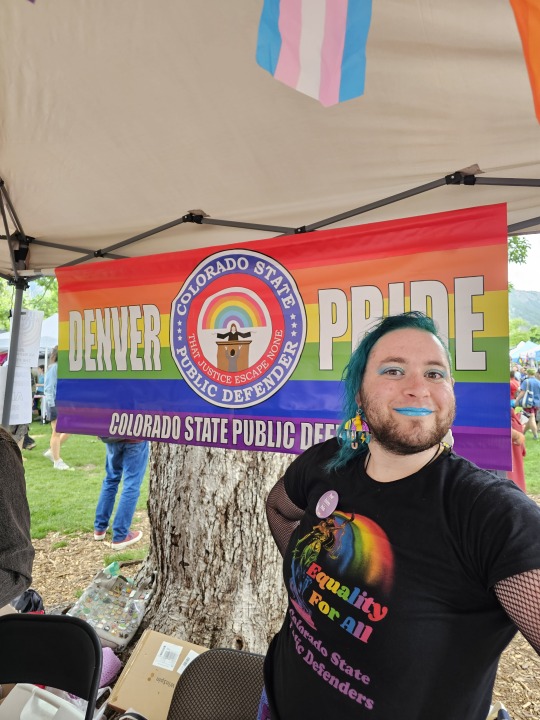
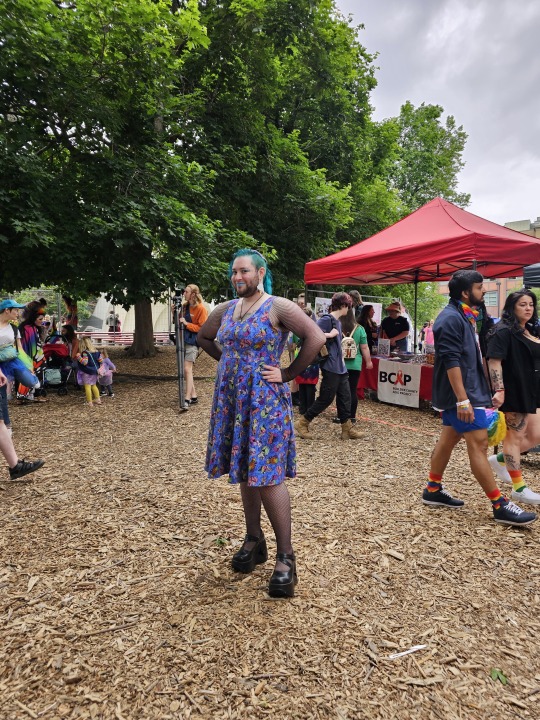
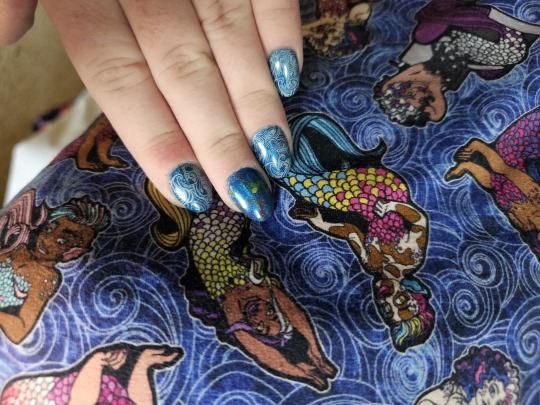

My dress and nails from the Pride events that I worked last weekend.
The dress is made out of fabric from Twisted Needle Textiles (currently changing management and will have a new name soon, but can still be found on facebook), and the nails are done with holotaco and stamps from Maniology.
I worked booths for my job, the Colorado State Public Defender. We educated people about their basic civil rights, and some queer legal history. For example, did you know that on the night of Stonewall, the police had a warrant for the illegal sale of alcohol, which allowed them to enter the Stonewall Inn and arrest people for crossdressing.
Happy Pride!
#trans man#lipstick#nails#jewish#trans#jewish trans man#transgender#make up#ftm#ftm femme#femme ftm#femme trans man#trans pride#happy pride 🌈#pride nails#pride month#merfolx#mermaids#twisted needle textiles#sewing adventures#dresses with pockets#handmade dress
76 notes
·
View notes
Text
Indie Fabric Store closing
Hey all! I just wanted to put a quick post out there about this store that I love that's closing this month. It's an independently owned fabric designer and she's amazing to work with!!!
You can see old fabric designs on her facebook page and ask her to add anything you don't see.
Final pre-order round ends 5/31. I highly recommend you check it out if you can.
Here are some pics of the fabric:




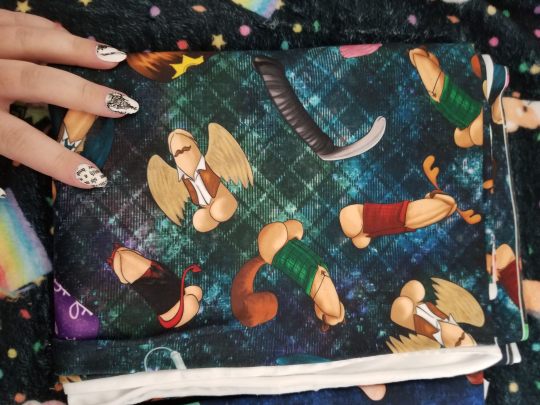
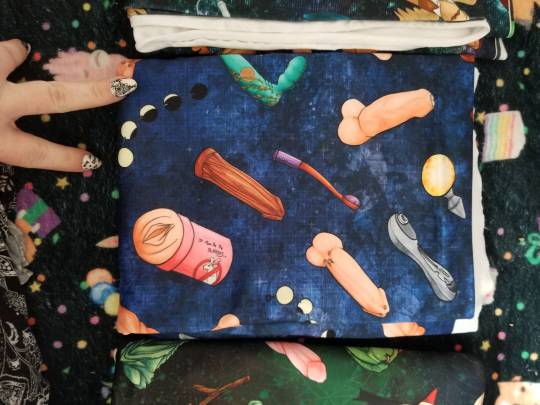



I tend to favor the penis fabric, but she has other designs too lol.
#twisted needle textiles#bipoc owned business#independently owned business#personal#penis fabric#sewing
3 notes
·
View notes
Text

3 new undies done 4 already cut out pairs to go. First time making this pattern. Kinda a pain with the gusset construction having to add elastic. If they fit great I’d make them again or maybe modify the leg bands to go all the way around. I do like the look of it
Boobs is bamboo lyrca from twisted needle textiles waistband is cotton lyrca I think from rockerbye
Care bear fabric is cotton lyrca from Al’s alley. Rainbow and glitter is cotton lyrca I think from wonderground. Pink stripes is cotton lyrca from shear madness
#sewing underwear#sewing clothes#Sinclair patterns#Sinclair bliss#shear madness fabric#twisted needle textiles#Al’s ally
1 note
·
View note
Text
A Fairy’s Gift
"I gift her with beauty."
"I gift her with grace."
"I gift her with kindness."
"I gift her with wit."
One by one, the fairies took their turn, each one bestowing a gift upon the newborn princess. This ceremony, which had been preformed for the royal families for ages now, was meant to show the strong bond the fairy kingdoms and the human kingdoms shared, even if that was now a lie.
Caorann refused to participate in this farce. She owed her enemy nothing, so, when her turn came, she did not step forward.
"I will not bestow a gift upon this child," she said. The king's face hardened.
"Cao..." Spruis said in a low tone.
"No," Caorann said to her elder. Disbelief filled the room. "They are taking our lands, destroying magic they don't understand-"
"Enough!" The king said. "This Christening is meant to be a truce, and you bring politics into it. The disrespect."
"A truce." Caorann mocked laughter. "Outside these walls, my people are dying by your people's hand, but in here there is a 'truce' so that your daughter can be granted our magical gifts. You are pathetic."
"Say that again and I will have your head," the king growled. "Now bestow your gift upon my daughter."
"No."
"Caorann," Spruis said. "Just give the child a gift and go."
Caorann stared at Spruis with anger, but he didn't flinch. How could he be okay with this, she couldn't understand.
"Fine." Caorann walked up to the child. "I have a gift for her. May harm never come her way." Caorann lips curled into a twisted smile. "Except for the needle of a spindle. If she ever pricks her finger on a spindle needle, she will instantly fall into an endless sleep, along with the rest of the kingdom."
Gasps collected among the crowd. The king sent guards to grab Caorann. She didn't resist as they held her back and dragged her from the room. She flashed a smile at the royal family as she was taken away.
The queen ran to her daughter and put her in her arms. "My baby."
Spruis approached the queen slowly. She shielded her child from him.
"I can't undo the curse," he said. "But I can alter it, if you wish."
"Alter how?" the king asked.
"I can add in a way to cure the curse, to wake up her and the rest of the kingdom."
"Do it," said the queen.
"We don't know if this is another trap," the king said.
"We are in danger because of you," the queen said. She turned back to the elder fairy. "Do it."
Spruis waved his wand. "If the kingdom ever falls into an endless sleep, all may be woken up when the son of a king wakes the princess."
"That's the best you can do!" The queen cried.
"Unfortunately, yes," Spruis said. "I am sorry."
"Get out," the king said. "All you worthless fairies, out! Now!"
The fairies left quickly and the celebration promptly ended. The king and queen retired to the nursery, not wanting to leave their child's side.
"What are we going to do?" The queen asked her husband, though her eyes never left the baby.
The king placed a hand around his wife and pulled her closer.
"The only thing we can do," he said. "We are going to burn every last spindle in this kingdom and every kingdom that surrounds us."
The queen pushed her husband away. "The kingdom will go broke. Our main export is textile."
"The war will finance us," the king said. "We will pillage every last fairy village for everything it's worth. Show those creatures what happens when they try to mess with our family."
"Your war is what caused our daughter to be cursed in the first place."
The king slapped the queen across her face. "Do not forget who it is you are talking to. I am your king."
The queen touched her burning cheek. She looked at her husband with rage.
"You," she said. "Are the man whose hubris doomed his daughter and his kingdom." She took a step closer. "You have failed as a king, as a father, as a husband. I know exactly the type of man I am talking to. Don't you forget which of us is the one with royal blood."
She began storming out of the nursery.
"My love," the king said.
The queen paused, turning back. "There is no love in this relationship. I regret my father's choice to have us marry. The kingdom I love will fall because you can't leave well enough alone."
She left without another word. The king turned to his daughter.
"Your mother has no faith in me," he said to her. "But I will protect you and my kingdom, even if it means killing every last fairy."
On the other side of the castle, stuck behind iron bars in a dirty cell, Caorann laughed to herself. She may be a prisoner, but this was a win for her people. Either way, through slumber or through financial demise, the kingdom would eventually fall.
* * * *
Enjoy that story? I post new flash fiction stories every week on my Patreon, it’d mean a lot to me if you’d check it out
179 notes
·
View notes
Text
Fiber Crafts
A resource for writers
Spinning: The process of winding fiber into thread or yarn. Can be done with a drop spindle or a spinning wheel. Can also be done on industrial machinery such as a spinning mule.
Plying: Taking two or more strands of spun thread and twisting them together to make a stronger yarn. Can be done on a spindle, spinning wheel, or machine.
Weaving: The process of forming cloth by interlacing two sets of threads, the warps (longitudinal) and the wefts (latitudinal), on a loom.
Bead Weaving: A type of weaving in which beads are woven into the fabric. This can be done with or without a loom.
Tapestry: A type of weaving in which only the weft threads can be seen from the front of the work, with all warp threads hidden on the back. Tapestries weave an image into the front of the work.
Nålbinding: A historic precursor to knitting, still practiced by the Nanti people of Peru. Nålbinding creates fabric by creating interlocking loops of yarn with a single-eyed needle. Nålbinding differs from knitting and crochet in that, in nålbinding, the entire length of the working yarn must be passed through each loop made.
Knitting: The process of forming cloth by interlocking loops of yarn. Knitting is most commonly done with two or more needles held in the hands, but can also be done with knitting looms or machines. The two most common methods of hand knitting are the English and Continental styles.
Crochet: The process of forming cloth by interlocking loops of yarn. This is most commonly done with a crochet hook, but can be done with the fingers. Crochet can also be done on looms. Whereas many stitches are active at any given time in knitting, in crochet, each stitch is finished before another is made.
Macramé: The process of creating textiles by making knots in cords. The main knots used in macramé are square knots and half-hitches.
Chinese Knotting: The process of knotting cord into decorations and charms.
Felting: The process of creating cloth by matting fibers together. In wet felting, fibers are exposed to water and then pressed and agitated to join the fibers together. In needle felting, fibers are joined by repeatedly being stabbed with specialized needles.
Rope Making: The process of braiding or twisting fibers together to create rope.
Sennit: The process of creating cord by braiding dried fibers.
Sewing: Using a needle and thread to join pieces of fabric. Sewing is done either by hand or machine. Sewing can be used to create garments and other items or to tailor preexisting items. Sewing can be either constructive (creating objects) or decorative (adorning objects).
Darning: A method of mending holes and worn areas in fabric. Darning can be either hand sewn or done with a machine, and weaves threads to fill in holes within fabric.
Embroidery: A form of sewing in which various stitches are added onto a preexisting fabric or item. Originally used for mending clothing, embroidery stitches are now also used decoratively. Embroidery can be done only with thread, but may also incorporate beads, sequins, and other decorative notions, such as beetle wings.
Cross-stitch: A type of embroidery in which the thread is sewn in X-shaped stitches across fabric.
Needlepoint: A type of embroidery in which yarn is stitched through an open weave canvas.
Tatting: The process of lace-making by looping and knotting thread. Tatting can be done with a shuttle, with a needle, or with a combination of tatting and crocheting techniques called cro-tatting.
Appliqué: The process of attaching one piece of fabric on top of a larger piece. Originally done to mend fabric, appliqué is now commonly used as decoration.
Patchwork: The process of sewing small pieces of fabric together to create a larger piece. This is often done to form a pattern or image.
Quilting: The process of stitching three or more layers of fabric together. Quilting is typically used to make blankets. Fabric layers can either be quilted by hand, usually with the aid of a quilting hoop, tied, or quilted using a domestic sewing machine or a longarm machine.
Banner Making: The process of creating a flag or banner. Banner making incorporates many other forms of needlework, such as patchwork, sewing, and embroidery.
Needlework: The umbrella term for textile handicrafts.
179 notes
·
View notes
Note
hello! i was wondering, in all the videos i've seen of north american people knitting, they seem to manually loop the yarn over the needle before every stitch, while here in europe i've always been taught to push the needle thorugh the stitch and pick it up with the needle rather pulling the yarn forward with my fingers. i was wondering how you have been taught, and why this american (?) way of knitting is used, since it seems to take a lot more time than just picking the yarn up with the needle. hope this explanation made sense. thank you <3
there are two main styles of knitting, one is referred to as "continental" which is where you hold the yarn in your left hand and pick the yarn with the needle and the other is referring to as "english style" or "throwing" where you hold the yarn in your right hand and 'throw' the yarn over the needle. most north americans and people in the UK are taught to knit english style, while others knit continental, but knitting continental is gaining more popularity in anglophone countries in recent years because it is generally faster due to it requiring less arm movement.
i'm not sure exactly why one style developed in anglophone countries or how it persisted all these years especially in can/usa which have had many settlers from continental europe, but i imagine it has something to do with knitting traditionally being passed down through families and taught from a young age so however you're taught to knit as a child is how you'd probably prefer to knit and then teach your kids using the same methods.
i have a feeling it might have something to do with the handspun yarn people used and the direction of twist placed into the yarn, because knitting continental twists the yarn itself slightly differently from knitting english style so I feel like, depending on the twist direction, knitting with one yarn english style could cause it to untwist/pull apart while knitting with the same yarn continental style could cause it to gain more twist. similar to how small changes in how the yarn is prepared prior to knitting (is it in a ball, or a centre pull cake, or some other method? centre pull cakes can impact the yarns' twist).
this is unfortunately vague because i read this some time ago but i remember reading in a magazine that, for example, the swedish tradition of twining while knitting (using two separate strands of yarn and alternating the strands with every stitch) benefitted best from the yarn being spun in a certain direction to aid in the effect, whereas if it was spun in the other direction the knitted fabric would distort and not 'work' as intended. so many decisions when it comes to textile traditions are based around and impacted by how much twist and the direction of twist put into the yarn used by that culture, so i have a strong feeling that has something to do with this question as well. idk for sure though re: english vs continental knitting, i'll have to do some research
58 notes
·
View notes
Note
i know i can look this up but what are the differences in the handcrafts. like. im pretty sure i learned somewhere that sewing and crocheting are different things but do you. or rather would you. explain? am genuinely curious please and thank you
Sewing is done with a needle and thread or a machine. It takes fabric and pieces it together for stuff.
Knitting takes two needles and yarn to make stuff. Crochet uses a hook and yarn. A lot of people joke about crocheters being hookers. That's why my business name is Hooking Hijinks.
Weaving takes yarn and fibers to make a textile. Spinning is taking raw wool and turning it into yarn!
All of these can be done by a machine except crochet. Crochet can't be replicated by machine because it's about different placement and making loops that are twisted.
14 notes
·
View notes
Text
Inspired after filo construction lesson on Monday
After the workshop I was inspired to look further into textiles. I took a look in the corridor with all the different mediums where you get to see so many different ideas for mediums and came across this one. It reminded me of the fur on Huggy bear so I wanted to see if I could resemble it in a weave.

Gillian in textiles was very kind to show me how to weave a rug pile wool. I weaved it onto a plasters s I also tried using felt wool but first I mixed 3 different colours and using the brushes I softened the wool. It also mixed the colour very well. I drew a heart with a permanent pen. I twisted a few strands of wool and Using a crochet needle with a latch I pulled through the wool and hooked it onto the plaster sheet I continued this process until I covered the whole heart. I enjoyed this process while I relaxed at home watching tv. It feels very soft and I think it definitely resembles a teddy bears fur.

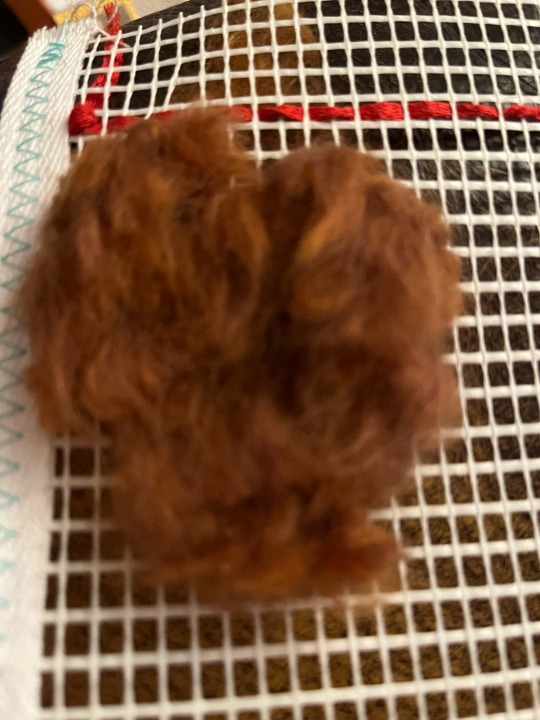
It may not be the perfect Heart but it’s close 🤣🤣
9 notes
·
View notes
Photo

Skeletal Lace Patterns Define the Copper Wire Vessels of Artist Suzanne Shafer-Wilson
At once malleable in material and secure in shape, the vessels that comprise Suzanne Shafer-Wilson’s body of work are intricate studies of texture, pattern, and space. The Illinois-based artist loops and twists lengths of wire into intricate baskets that range in size from 20 inches tall to the width of a fingertip. Using a technique similar to the one employed by sculptor Ruth Asawa to create her rounded, metallic forms, Shafer-Wilson works with an Italian needle lace method designed for fibers like wool and silk. She intertwines brass, copper, or sterling silver in place of textiles and fashions porous vessels with wide, gaping bodies and elaborately constructed outer walls.
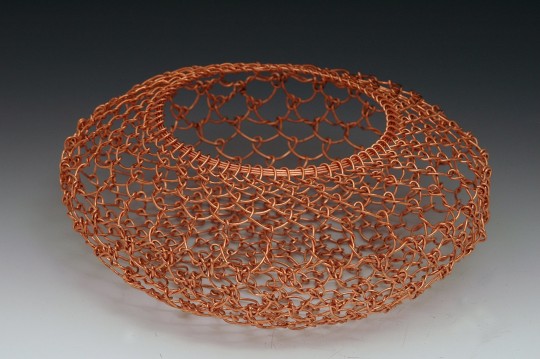

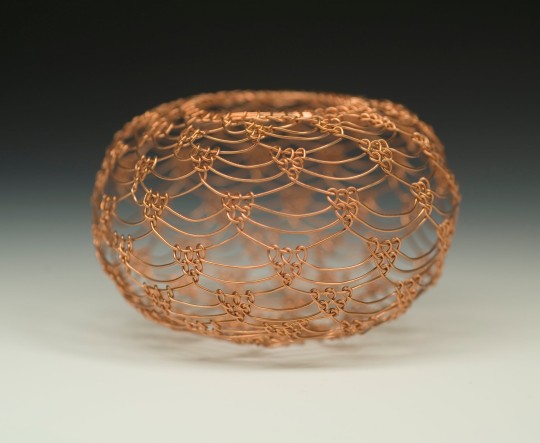

#suzanne shafer-wilson#artist#art#skeletal lace patterns#copper wire vessels#texture#pattern#space#illinois-based artist#wire#sculptor#ruth asawa#brass#copper#sterling silver#sculpture
4 notes
·
View notes
Text
Choosing the Right Fabric: A Consumer's Handbook
Choosing the right fabric is like crafting the framework for a masterpiece when it comes to fashion, home décor, and crafts. Understanding the world of textiles can occasionally feel difficult due to the variety of alternatives available, each with their own distinct qualities and purposes. Be confident, as this consumer guide will help you understand the maze of embroidered, printed, weaving, tie-dye, and block-printed fabrics, enabling you to make the correct choices that match your style and requirements.
Embroidered Fabrics: Adding Elegance and Texture
Embroidered fabrics are adorned with intricate designs crafted using needle and thread, lending a touch of sophistication and luxury to any garment or decor item. Whether it's delicate floral motifs or elaborate patterns, embroidered fabrics exude timeless charm and elegance. Perfect for formal attire, evening gowns, or embellishing home furnishings, these fabrics elevate the artistic appeal with their exquisite detailing and texture.
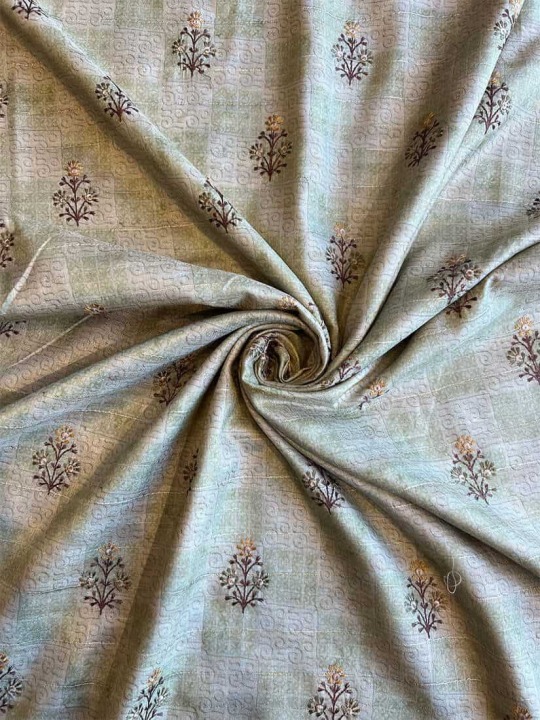
Printed Fabrics: Infusing Vibrancy and Versatility
A wide range of designs, colours, and themes can be found on printed fabrics, which makes them an excellent option for a variety of projects. The options are endless and include both geometric and floral motifs. Printed fabrics provide endless creative possibilities for anything from bold home accents to distinctive clothing to eye-catching quilts. With a variety of materials to choose from, including silk and cotton, each with its own distinct drape and feel, you may find the perfect fit.

Weaved Fabrics: Embracing Timeless Tradition
Weaved fabrics, chosen by their woven threads, provide witness to the ancient art of textile manufacture. These textiles, which range from elegant silk blends to crisp cotton weaves, are the epitome of both strength and grace. Worn with tailored suits or skirts, or any other clothing that needs support and structure, weaved fabrics have a polished appearance and great drape. Try a range of weave patterns, like satin, plain weave, and twill, to get the ideal look and performance.

Tie & Dye Fabrics: Celebrating Artisanal Craftsmanship
Tie & dye fabrics, also known as shibori or bandhani, are steeped in cultural heritage and artisanal craftsmanship. This ancient dyeing technique involves binding, folding, or twisting fabric before immersing it in vibrant dyes, resulting in mesmerising patterns and gradients. Whether you're drawn to bold tie-dye t-shirts or intricate shibori scarves, these fabrics offer a unique blend of artistry and individuality. Embrace the imperfections and irregularities that characterise tie & dye fabrics, as they embody the essence of handmade charm.
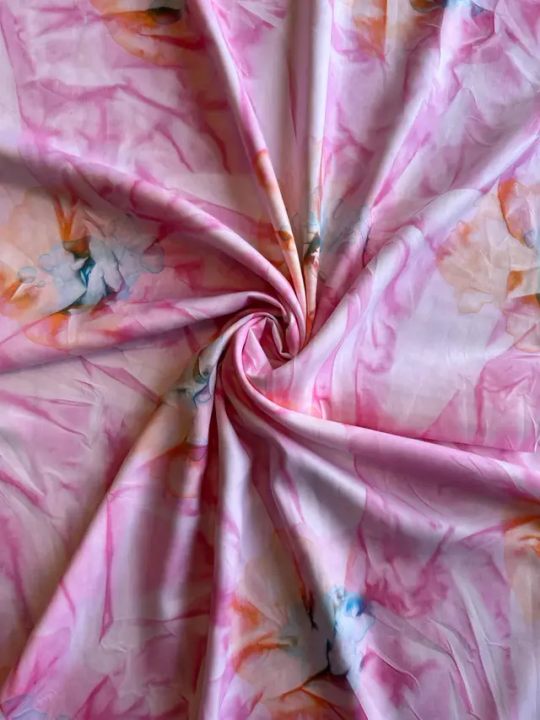
Block Prints Fabrics: Capturing Traditional Artistry
Fabrics with block prints have sophisticated motifs carved into wooden blocks; each stroke tells a tale of traditional craftsmanship and cultural history. Block printing is a technique that originated in places like Indonesia and India. It is a method of carefully stamping designs onto cloth to create textured and aesthetically appealing motifs. Block prints fabrics add warmth and character to interiors and reflect the rich tapestry of global workmanship in everything from bohemian-inspired garments to eccentric home furniture.

Conclusion :The art of choosing the right fabric lies in understanding its inherent qualities, uses, and cultural significance. Whether you're drawn to the elegance of embroidered fabrics, the versatility of printed fabrics, the tradition of weaved fabrics, the artistry of tie-and-dye fabrics, or the heritage of block-printed fabrics, let your creative vision and project requirements be your guide. Armed with knowledge and inspiration, embark on your fabric journey with confidence, knowing that the perfect textile awaits to bring your creations to life.
0 notes
Text

This is another creative sample I wanted to experiment with based on Mexicans Los Muertos make up they wear to respect the dead.
I wanted to further develop my skills and see what I can do to create a similar aspect based on Mexico traditions with the skull aesthetic make up.
To construct this textiles sample, I first choose a portrait photo of a woman and print this using the digital printer,on a black A4 size fabric.Once it was all printed off and dry, then I could start the embroidery techniques. I chose a few designs I could do on the face and improvised from a vision of mine to build a detailed and textile effect bringing this sample to life.I chose different bright colours to outline all the details and filled them in with colour by using an embroidery hoop to sustain it and not come loose.once all the details were added I went over and outlined them in black.
When I got to the teeth, I had to move fast and carefully to not go over the lines and ruin the shape. Although once I have filled them in, there was too much thread gathering and harder for the needle to go through. I finished them with the same technique for the first row and decided to try something different for the bottom teeth to see what would cooperate better. I thought of using puff binding for the teeth as it was easier for me to sew on around with lack after drying it off.
My last step was to add the 3D marigold flowers to add the last touches.I used the same method of hand stitching and some in the machine. Sewing them in the middle and twisting them around till I get the shape I wanted.
Overall this was an interesting sample I got to finish and experience the new skills with materials I could combine and build together to create something amazing based on Mexico’s traditions.I think this would be a very eye catching print on my final designs as I could interpret this as a similar textiles technique.
#get creative#Mexico#mexican style#traditions#machine and hand embroidery#hand techniques#develop and experiment#digital print on fabric
0 notes
Text


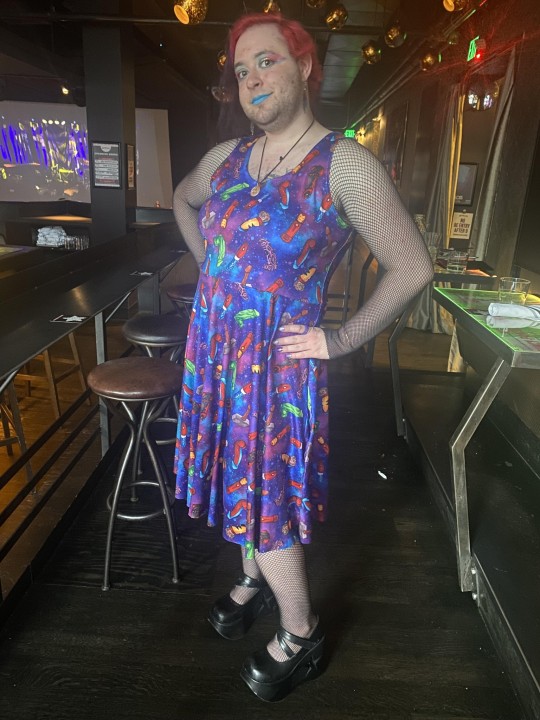

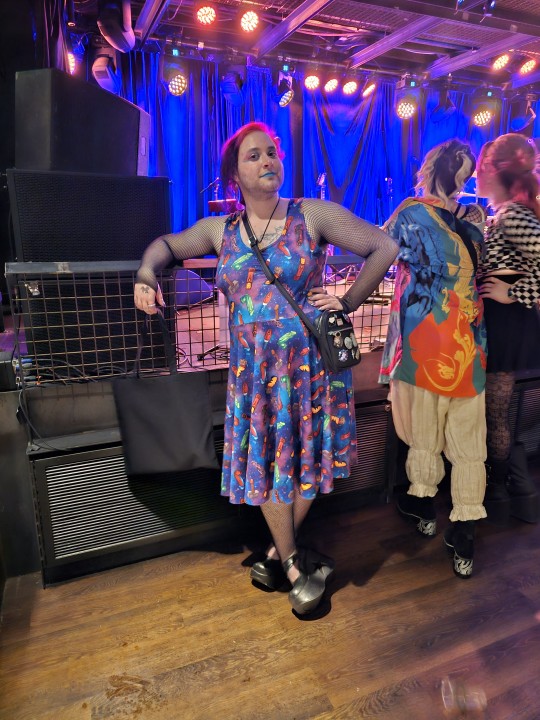
Pics of my recent outfit that I wore to the Dresden Dolls concert.
I made the dress myself with fabric from Twisted Needle Textiles (if you want any fabric the store is closing this month so get your orders in soon!).
We waited after the show with the hopes Amanda Palmer would sign an old poster of mine. My mom got me this poster when I was too young to go to the show, and it only had Brian Viglione's signature, and it also had my deadname on it. After some tense waiting, and some mis-information from security, Amanda came out and was just hanging out. She was happy to sign my poster with my new name, and she connected with my mom as well.

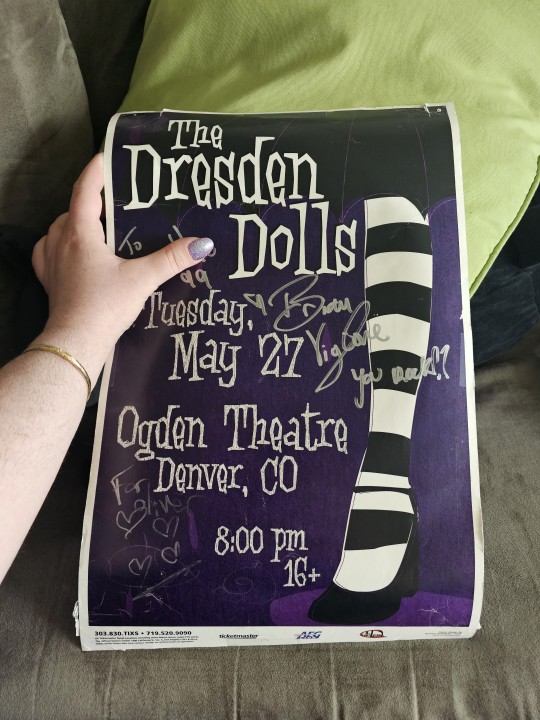
Apparently it ended up being a meaningful connection for her as well, because she posted about us the next day!!!! Amanda Palmer is my favorite singer of all time, so its incredible to have had this exchange.

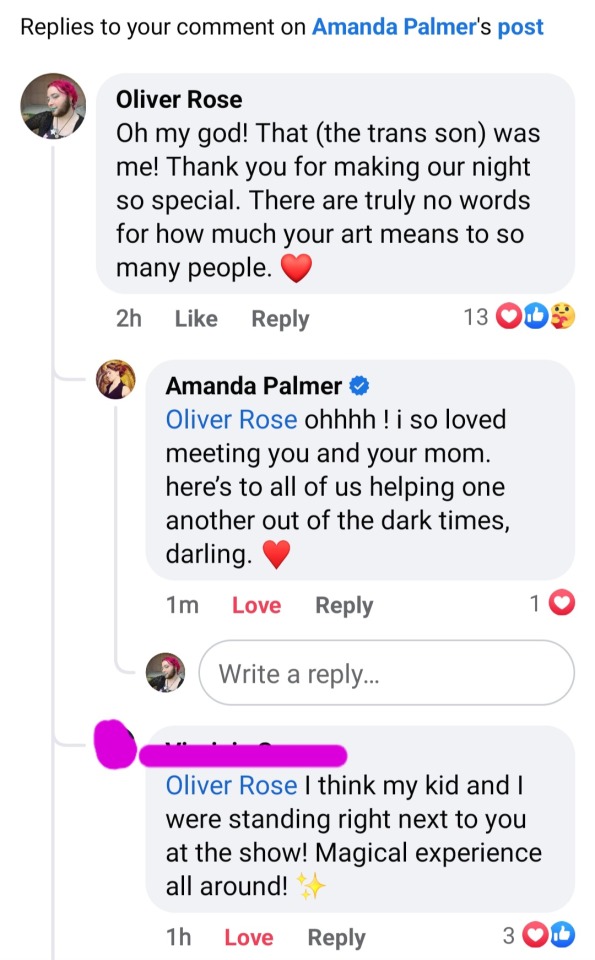
#ftm#transgender#trans man#lipstick#trans#eye makeup#femme trans guy#femme trans man#jewish trans man#the dresden dolls#amanda palmer#brian viglione#penis fabric#twisted needle textiles#personal
12 notes
·
View notes
Text
Was nervous bc my first pocket failed and I've been meaning to make another mock-up, but now I'm making a skirt for my mom's birthday and planning for a trip in a few days, so I'm just hoping this turns out. I did spend a long time pinning and did a couple tacking stitches, but am skipping basting stitches, so I'm super happy that this turned out well!

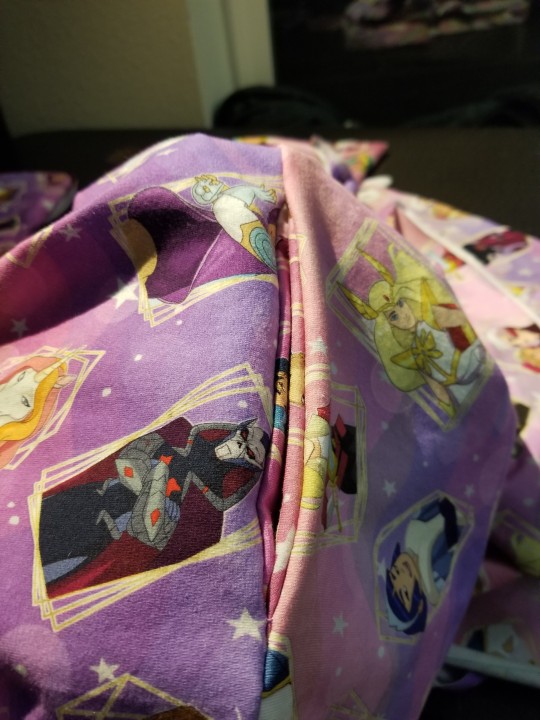

Fabric is from Twisted Needle Textiles. Very high quality, BIPOC owned. Love them.
5 notes
·
View notes
Text
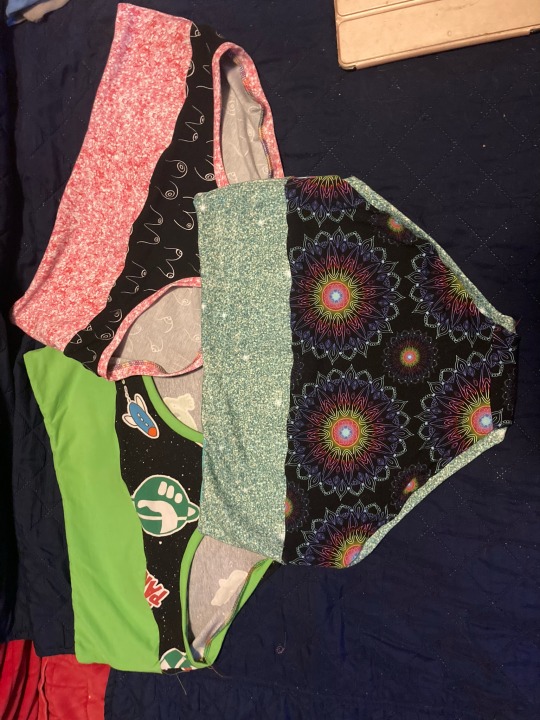
Got 3 pairs sewn up. Damn my couch cover is dirty
I have to break out the sewing machine to continue making the new patterns ones. I hate having to swap machines
Boobs and vagina mandalas is bamboo lyrca main from twisted needle textiles Bands cotton lyrca I don’t remember where either are from but most likely wonderground
Hitchhikers guide to the galaxy is all cotton lyrca, main from geek garden
#sewing clothes#sewing underwear#Sinclair patterns#Sinclair Kiki#twisted needle textiles#geek garden fabric
0 notes
Text
Exploring the Fusion of Korean Candle Making, Tufting, Russian Embroidery, and Korean Fashion

In a world where cultural exchange and creative fusion reign supreme, the realms of art and design are constantly evolving. Today, we delve into a captivating blend of traditional Korean candle making, the intricate art of tufting, the rich heritage of Russian embroidery, and the vibrant world of Korean fashion. Let's embark on a journey that intertwines these diverse elements into a tapestry of creativity and innovation.
韓式蠟燭
First, let's illuminate the scene with the art of Korean candle making, known as "韓式蠟燭." Rooted in centuries-old traditions, Korean candle making is a delicate craft that combines natural ingredients and meticulous techniques. These candles, often adorned with intricate patterns and designs, evoke a sense of tranquility and elegance, making them cherished decorative pieces in Korean culture.
Tufting
Now, let's add a touch of texture with tufting, a technique that has surged in popularity in recent years. Originating from the weaving traditions of ancient civilizations, tufting involves the creation of raised patterns or designs on fabric using a tufting gun or needle. The juxtaposition of soft, plush fibers against a smooth surface adds depth and dimension to any textile, transforming it into a tactile work of art.
As we thread through our narrative, we encounter the rich tapestry of Russian embroidery, or "俄羅斯刺繡." Renowned for its intricate stitches and vibrant color palette, Russian embroidery has a storied history dating back centuries. From traditional folk motifs to elaborate floral patterns, each stitch carries the legacy of generations past, celebrating Russia's cultural heritage in every thread.
俄羅斯刺繡
Now, let's tie it all together with a sartorial twist – Korean fashion, where tradition meets modernity in a harmonious blend of style and innovation. With its bold colors, dynamic silhouettes, and avant-garde designs, Korean fashion has captivated the global stage, influencing trends and inspiring fashionistas worldwide. From the sleek sophistication of Seoul's high-end boutiques to the eclectic streetwear scene, Korean fashion embraces diversity and creativity, redefining the boundaries of style.
But what happens when we merge these seemingly disparate elements into a single narrative? The result is nothing short of extraordinary – a fusion of cultural influences that transcends boundaries and defies categorization. Imagine a tufted tapestry adorned with motifs inspired by Korean candle designs, intricately embroidered with Russian patterns, transformed into avant-garde fashion pieces that bridge the gap between past and present.
韓國服裝
Picture a runway ablaze with color and creativity, where models strut confidently in garments that celebrate the diversity of our world. Each ensemble tells a story – of heritage and tradition, of innovation and reinvention. In this tapestry of creativity, there are no limits, only endless possibilities waiting to be explored.
In conclusion, the fusion of Korean candle making, tufting, Russian embroidery, and Korean fashion represents a celebration of diversity, creativity, and cultural exchange. It reminds us that art knows no boundaries – it transcends language, geography, and time, uniting us in a shared appreciation for beauty and craftsmanship. So let us embrace this fusion of traditions and forge new paths forward, guided by the spirit of creativity and collaboration.
0 notes
Text
The Cotton Yarn Chronicles: A Thread of Growth and Sustainability

Unraveling the Market Size Tango
In the dazzling dance of market numbers, the Global Cotton Yarn market took center stage, boasting a whopping USD 58.45 billion in 2021. Hold on to your knitting needles because it’s projected to pirouette its way to USD 107.64 billion by 2030, shimmying at a CAGR of 7.02%.
Threads of Transformation: Types and Applications
Carded Yarn vs. Combed Yarn: Move over superhero rivalries; the real showdown is between carded and combed yarn. The carded yarn, a cotton crusader, fights off short fibers and impurities. Meanwhile, combed yarn, the refined aristocrat, undergoes a meticulous combing process, emerging as the smoother, finer contender. Cue dramatic yarn showdown music!
Applications Galore: Home textiles and apparel take the spotlight, with cotton yarn playing the lead role in creating everything from cozy bed linens to runway-worthy fashion. It’s like the cotton yarn is the Hollywood of the textile industry!
Market Dynamics: The Sustainable Waltz
Driving Forces:
Sustainability Soirée: The fashion industry is shaking hands with sustainability, and cotton yarn is the dance partner of choice. As eco-consciousness spreads, the demand for organic cotton shoots up, making cotton yarn the belle of the sustainable ball.
Obstacle Tango:
Pricy Pirouette: Here’s the catch — cotton yarn does a pricey pirouette compared to its synthetic counterparts. Blame it on cottonseed expenses and farming procedures. Synthetic yarns, the frugal dancers, steal the spotlight with cost-effective moves.
Regional Revelry: From U.S. Textile Tango to Asia Pacific Fiesta
North America:
Textile Tango: The U.S. textile sector flaunts its fabric finesse, weaving a rich tapestry from cotton, wool, and synthetic fibers. Bravo, North America!
Asia Pacific:
Billion-Dollar Ballet: Asia Pacific leads the charge with a market value of USD 77.21 billion in 2022. It’s like the Asia Pacific region is the prima ballerina of the textile stage, twirling its way to dominance.
Competitive Landscape: The Textile Thunderdome
In the textile Thunderdome, brands like Texhong, Weiqiao Textile, and Huafu are flexing their innovation muscles. From Kikkoman’s foray into the Indian market to Cauldron Foods spicing up the game with Smoky BBQ Cotton Yarn, it’s a fierce competition of flavors and trends.
For More Information: https://www.skyquestt.com/report/cotton-yarn-market
The Grand Finale: Market Insights and Your Front-Row Seat
As the curtain falls on this cotton yarn extravaganza, the market reveals itself as a dynamic playground. Combed or carded, home textiles or apparel, every twist and turn tells a story of growth, sustainability, and a hint of textile drama.
So, there you have it, the Cotton Yarn Chronicles — where threads meet trends, and sustainability takes the spotlight. Until next time, keep spinning those yarns, textile enthusiasts! 🧶✨
About Us-
SkyQuest Technology Group is a Global Market Intelligence, Innovation Management & Commercialization organization that connects innovation to new markets, networks & collaborators for achieving Sustainable Development Goals.
Contact Us-
SkyQuest Technology Consulting Pvt. Ltd.
1 Apache Way,
Westford,
Massachusetts 01886
USA (+1) 617–230–0741
Email- [email protected]
Website: https://www.skyquestt.com
0 notes